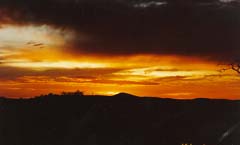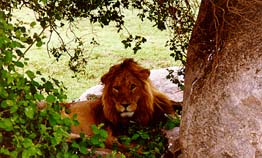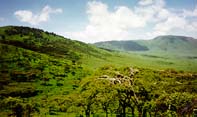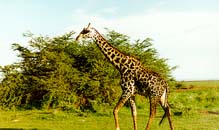

There is no better way than a camping safari to truly experience the African Bush. After the excitement of game viewing all day, you return to your campsite where another adventure begins. It may be gazelles making their way to a favorite watering hole or curious baboons wanting to inspect your tent while all around you the sky is emblazoned with the brilliant colors that make East African sunsets famous. As night falls, the heavens come alive with millions of stars that seem so close, you could almost pluck them from the skies. While you drift off to sleep, you can hear lions roar and an impala calling for a mate as strange shadows fall across the canvas of your tent.
The most popular safari destination in Tanzania is the
 Northern Safari Circuit which includes the Serengeti, Ngorongoro Crater,
and the National Parks of Lake Manyara, Tarangire, Arusha and Mt. Kilimanjaro.
In all of Africa, nowhere else provides the sheer numbers and varieties
of game or the ease with which they can be viewed. Each park has its own
distinctive habitats and their proximity to each other allows for a satisfying
safari experience in a relatively short period of time.
Northern Safari Circuit which includes the Serengeti, Ngorongoro Crater,
and the National Parks of Lake Manyara, Tarangire, Arusha and Mt. Kilimanjaro.
In all of Africa, nowhere else provides the sheer numbers and varieties
of game or the ease with which they can be viewed. Each park has its own
distinctive habitats and their proximity to each other allows for a satisfying
safari experience in a relatively short period of time.
A camping safari can range from a budget tour where you
are expected to pitch your own tent and help with the cooking to the luxurious
with a private campsite, walk-in canvas tents with cots, uniformed waiters
 and portable shower and toilet facilities. However, most visitors utilize
a full service camping safari where regular park campsites and facilities
are used and a driver/guide and cook are responsible for all camp chores.
Tour operators are generally flexible and are willing to customize your
safari to allow for your special interests or requirements. If a week is
too long for you to go without a shower, you may want to request a night
in a permanent tented lodge which has an ensuite bathroom with hot water
and flush toilets. A safari is always an adventure of a lifetime but a
camping safari authenticates the experience and satisfies one's fantasies
of the romance of a bygone era.
and portable shower and toilet facilities. However, most visitors utilize
a full service camping safari where regular park campsites and facilities
are used and a driver/guide and cook are responsible for all camp chores.
Tour operators are generally flexible and are willing to customize your
safari to allow for your special interests or requirements. If a week is
too long for you to go without a shower, you may want to request a night
in a permanent tented lodge which has an ensuite bathroom with hot water
and flush toilets. A safari is always an adventure of a lifetime but a
camping safari authenticates the experience and satisfies one's fantasies
of the romance of a bygone era.
Best Times to Go: While December to March
is a rewarding period, February is best. Masses of migratory herds are
on the short grass of the southern Serengeti Plains at this time. It is
 also the birthing season for the wildebeest and the hartebeest and it is
always a thrill to watch a baby wildebeest stumble to its feet minutes
after being born. The southern Serengeti is the area nearest to the other
parks so you are assured of a memorable safari even if you are on a tight
schedule. From a practical standpoint, in February, the land is verdant
with meadows of wildflowers, the dust is minimal and there are fewer safari
vehicles in the parks.
also the birthing season for the wildebeest and the hartebeest and it is
always a thrill to watch a baby wildebeest stumble to its feet minutes
after being born. The southern Serengeti is the area nearest to the other
parks so you are assured of a memorable safari even if you are on a tight
schedule. From a practical standpoint, in February, the land is verdant
with meadows of wildflowers, the dust is minimal and there are fewer safari
vehicles in the parks.
Getting There: Northern Circuit safaris originate in Arusha. From Europe, KLM flies directly to Kilimanjaro International Airport. Overland, buses are available from Nairobi, Dar-es-Salaam and Mombasa via Tanga.
Clothing/Gear: Pack lightly, preferably just one bag. Your tour company will store your excess baggage. Days are warm and nights are cool, especially on the rim of the Ngorongoro Crater with an altitude of about 7500ft. Be sure to take a camera with spare batteries and lots of film, binoculars, flashlight, a wide brimmed hat with a drawstring, good walking shoes, insect repellent, suntan lotion, personal toiletries and a sleeping bag if you do not plan to use a full service outfitter.
General Information: If you have a limited time for your camping safari, it is better to make arrangements with a tour operator in advance. This will ensure your ability to visit the parks of your choice since there are restrictions as to the number of vehicles allowed in each park. A passport, visa, and yellow fever certificate are required. There are exceptions to the visa and vaccination requirements but it is advisable to check with the Tanzanian Embassy for current regulations.
It is difficult to compare the costs of camping safaris.
This is because there are so many variables involved. These include the
 number of people in your group and a vast range in the levels of service
to be provided. On a fixed schedule, it is better to pay more for a full
service camping safari and the reassurance of a worry-free adventure. Full
service camping safaris range from about $100-200 per person, per day.
The price difference reflects the size and comfort of the tents, the reliability
of the vehicles, and the caliber of the driver/guides etc. Feel free to
ask your tour operator for specific information. A luxury camping
safari will cost considerably more. Tips should also be budgeted for your
driver/guide and cook. Ask your tour operator for recommendations.
number of people in your group and a vast range in the levels of service
to be provided. On a fixed schedule, it is better to pay more for a full
service camping safari and the reassurance of a worry-free adventure. Full
service camping safaris range from about $100-200 per person, per day.
The price difference reflects the size and comfort of the tents, the reliability
of the vehicles, and the caliber of the driver/guides etc. Feel free to
ask your tour operator for specific information. A luxury camping
safari will cost considerably more. Tips should also be budgeted for your
driver/guide and cook. Ask your tour operator for recommendations.
Do's and Don'ts:
Important Resources:
Classic Tours & Safaris
PO Box 7302
Arusha, Tanzania
Tel: 255-27-2502398/2502962
Fax: 255-27-2508220/2508680
Email:impala@yako.habari.co.tz
Classic Tours & Safaris offers excellent service and reliable vehicles. It is located on the premises of the Impala Hotel, one of the nicer facilities in Arusha. The staff is consistently helpful and efficient.
Equatorial Safaris Ltd.
PO Box 2156
Arusha, Tanzania
Tel: 255-27-2501163
Fax: 255-27-2502617
Email:
equatorial@yako.habari.co.tz
Related Books:

© copyright 1996 Adventures Great and Small